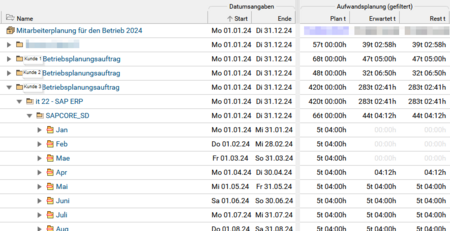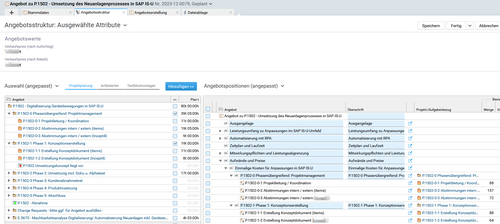Projektron BCS is the central data platform and source of information
User report from items GmbH & Co. KG
In addition to traditional project work, items supports its customers in a wide variety of ways in their day-to-day business. This results in a wide range of additional requirements for a tool for integrated planning and processing of corresponding customer orders. With Projektron BCS, we have found a system that optimally covers the range of our requirements.
items - Shaping innovation sustainably
Founded in 1999, items has developed into one of the leading service companies in the energy industry and is a full-service provider for the utilities and mobility sector, for municipal utilities and local authorities. items currently employs around 370 people and continues to grow.
As an industry specialist and innovation driver, we offer IT infrastructure, consulting and process services with a focus on cooperation platforms, IoT integration of smart city technologies, AI products and robotics. We secure and increase the quality of life and performance in cities and regions through networking, digitalization and automation.
A new system was needed!
Due to our wide range of services, we never needed just project management software, but a solution that also supported planning, structured expense recording and invoicing for our other areas of activity. Since the company was founded, we had been using an Access-based in-house development (as a client) in conjunction with an MS SQL server (as a database). However, this application was very limited in its range of functions and prone to errors. For example, it only had very rudimentary options for project planning and evaluation, which could hardly be used by project managers and employees, but rather at admin level.
With a growing number of projects and project participants - and with the increased methodological know-how of all those involved - our requirements in (multi-)project management and project controlling as well as in the billing of our services to our customers increased. Last but not least, as the number of employees and customer orders continued to grow, it became necessary to have a tool for resource monitoring and planning.
At the same time, it became clear that our old system was not audit-proof, and trouble-free operation and necessary further developments could not be guaranteed, as all these tasks were the responsibility of just one employee. In short: by the end of 2009, the pain threshold had been reached - a new system was needed!
Selection process and decision for Projektron BCS
We carried out a market research during which we became aware of Projektron BCS.
As part of the system selection process, Projektron provided us with role-related training and a free test installation on which we were able to check the feasibility of the requirements from the requirements catalog we had drawn up with support.
Criteria such as the following were decisive for us in the selection process:
(1) A comprehensive, integrated range of functions with at least one time recording, billing and project management component, which also allows a jump to the relevant sub-processes across all processes.
(2) The ability to implement a lean billing process not only for our projects, but also for services outside of projects (services from service contracts priced at a flat rate and also expense-related service billing) for our customers.
(3) The customizability of the software, both in terms of the visual presentation and the ability to expand the data model to include customer-specific fields and functions. Customizations should also be able to be implemented by our own trained administrators.
(4) With another software product we used, we had bad experiences regarding the release stability of programmed and configured customizations. Therefore, the new solution should definitely have a high level of release stability for customizations made and be open-platform and browser-based - just like Projektron BCS.
(5) In order to be prepared for the planned company growth with an increase in users, projects and services to be processed and their billing, the scalability of the new system was very important to us, a condition that BCS fulfills very well.
(6) Last but not least, from a data protection perspective, it was imperative that the views of different user groups on data could be set up and delimited as required. Here too, BCS scored highly with its granular yet clear assignment of authorizations.
After several months of system setup, employee preparation and finally a data transfer from the old system, we started using BCS in mid-2011. Due to the problems we foresaw with a gradual changeover to the new system within ongoing processes, we opted for a "big bang": we switched the expense recording for all employees to BCS immediately from the start, and all projects, payroll accounting and vacation requests/approvals were only run in the new system from this point onwards.
Despite some (expected) difficulties in the start-up phase, such as the need for technical readjustments or additional training for individual user groups, this decision ultimately proved to be the right one.
Utilization and further development of BCS functionalities at items
(A) Project planning and implementation with BCS
In the area of project planning and implementation as well as resource planning, we have made few adjustments overall and have instead successively expanded our use of the system within the available system standards.
In doing so, we rely heavily on the use of templates that are used to implement specifications for projects based on the GPM standards (e.g. phase models). We also use various authorization profiles for project managers to take account of the different knowledge and needs of users.
In particular, our full-time project managers are continuously trained and coached in the system-supported planning and implementation of our large projects with BCS. Accordingly, they have the most comprehensive access to the BCS functions when managing and monitoring projects, unlike system users who never work in projects or have no management tasks there. We also test new BCS functionalities with this group of people before making them available to other users in the company.
(B) Resource planning
To accompany the use of the above-mentioned basic BCS functions, a multi-level resource planning system was gradually developed for HR managers:
The basis for this is the comprehensive recording of all (also internal, non-billable) hours, as well as the complete documentation of all absences. Requests for and approval of time off in lieu (FZA) and vacation take place in BCS, other absences are loaded from SAP HCM, which is our leading system for personnel management.
Resource planning had to take account of a company-specific challenge for us, namely the coexistence of planned project work and unplannable ad hoc customer requirements (specialist and technical support in day-to-day business). Based on past experience, we map these activities for each calendar year in a project-like structure, which is maintained by the HR managers and taken into account in the employee workload forecast.
In addition, the rough (including personnel) "preliminary planning" of probable medium-term projects plays an important role. This takes place in cooperation between our sales staff and the designated project managers. These "forecast projects" are refined over time until they may lead to offers and, in the best case, to commissioning and implementation. The employees involved in these potential projects are also planned (possibly as placeholders). This procedure serves to proactively avoid personnel bottlenecks and permanently update the basis for timely personnel planning and procurement.
Introduction of quotation preparation with BCS at the end of 2020
For a long time, the consistent implementation of project and personnel planning was significantly disrupted by the fact that quotations were not submitted in BCS, but in another system that was introduced before BCS but was never connected to it. As a result, it was often the case that unplanned projects - sometimes directly from the specialist teams - were offered without involving the sales managers. When they were commissioned, they then had to be entered in BCS in a largely manual, very time-consuming and error-prone process in order to be able to carry them out, post and invoice them there.
It was therefore fortunate that the external system had to be replaced for technical reasons and that we were able to convince our sales colleagues to use the BCS quotation module when selecting the successor solution.
In the course of setting up BCS for the new task of preparing quotations, we redefined the processes from project planning to commissioning and have been "productive" with it since December 2020.
This step was a real breakthrough because it enabled us to rectify several issues at once:
(1) We now strictly follow the principle of "no quotation without preliminary planning" in BCS. This principle must be adhered to, as quotations may and can only be created from pre-planned projects. As a result, there is no longer any manual re-entry of projects after receipt of an order, and the additional effort and errors involved are avoided.
(2) The sales staff can now finally take on the commercial responsibility for quotations that has always been assigned to them, as they are the ones who "make the prices", send the quotations, accept and check orders and set the orders in BCS. This means that they are always informed about quotations to customers and their status; nothing gets past them.
(3) All quotations to customers now comply with our specified company standards, thanks to automatic formatting and the addition of standard texts (including customer-specific texts) in the BCS quotation report used.
(4) When an order is placed, the items checked by the sales managers are assigned an order value by the system (and not manually as before), thus creating a very reliable basis for subsequent invoicing. This also provides the sales team with unprecedented transparency regarding order statuses, order history, quotation versions, etc.
(5) Last but not least: The previously existing planning gap for the use of personnel resources for upcoming projects (as they have already been offered) is closed, as the implementation periods and the employees deployed (at least their placeholders) are already planned during the preliminary planning for the preparation of the quotation.
Although the process steps still need to be practiced over and over again, constant retraining of those involved, who naturally change from time to time, and constant monitoring, especially of deadline maintenance in planned and ongoing projects, we are on a very good and definitely correct path.
Mapping of specifics in service recording and invoicing
For invoicing with BCS, we have implemented many adaptations and enhancements to the system with the support of Projektron since the beginning due to individual requirements, some of which have also been incorporated into the BCS standard.
As we operate an IT service management system organized strictly according to ITIL for our support services outside of projects, we have been using an external ticket system for many years in which the customer-specific, contract-based service level agreements are mapped and the prescribed processes are managed according to ITIL rules. The services commissioned via the external ticket system are also billed using Projektron BCS.
This ticket system was connected to Projektron BCS by Projektron GmbH in such a way that the necessary information from the ticket order is imported at close intervals and is available there for effort recording.
To make it particularly easy for our employees to record their ticket-related expenses, a special new booking screen has been created in BCS, in which the task to be booked is automatically determined on the basis of the ticket number entered using a stored logic. This eliminates the need for time-consuming searching for booking tasks by the employee.
In addition to the hours spent by employees and benefits in kind such as licenses, software products and hardware, the resources used by customers in items' data centers (e.g. storage space, databases, user accounts, etc.) must also be invoiced using BCS. The information on such measured values is automatically loaded into BCS via an interface and taken into account there when invoicing.
The billing of these projects can be implemented centrally and clearly via BCS with little effort. BCS also offers a wide range of options for billing other services from service contracts (one-off, cyclically recurring, generally scheduled) that are provided for customers outside of projects.
The services invoiced in BCS are then transferred to SAP via an interface, where they are incorporated into organization-based profit center accounting and cost unit accounting as an integral part of the revenue side.
Conclusion: Optimizations and new fields of application
Even after many years, we have not yet exhausted the many other functions of the system and are constantly discovering potential optimizations or new fields of application, also initiated by our participation in Projektron training courses, release presentations and user conferences. For example, we have so far made little use of the tools offered in BCS for project implementation and will expand this in future. There is also room for improvement in terms of personnel and deployment planning. We're staying on the ball!
We still have a largely untapped treasure trove of possibilities in the use of the BCS BPMN module for the automation of workflows, a topic that we will be looking at more closely in the future.
For the functions of the system currently in use, we can say that Projektron BCS has proven itself over the 13 years we have been using it:
(1) a stable solution for mapping and monitoring central company processes, e.g. quotations, billing processes, project implementation, personnel planning.
(2) Central data platform from which processes handled directly with the BCS are fed, e.g. invoicing, project reporting). On the other hand, data is transferred from the BCS to special systems for further processing, e.g. SAP systems for human resources management and corporate controlling.
(3) Important and reliable source of information for all topics mapped in BCS - for management, sales staff, project management office, project managers, HR managers, employees.
















